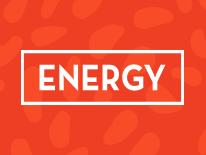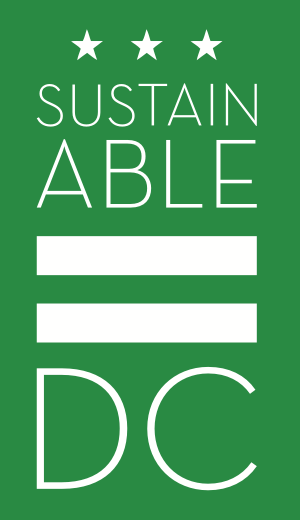

Energy literally powers our city—it lights our buildings, heats and cools our homes, and runs our motorized vehicles. However, generating energy from fossil fuels—such as coal, oil, and gas—releases greenhouse gases that cause climate change. Climate change results in more intense and frequent extreme weather in the District such as flooding and heat waves.
Energy generation from fossil fuels also worsens air quality and, as a result, negatively impacts human health. To help avoid the worst impacts of climate change and improve air quality, the District is working to reduce energy use overall and shift the power supply to renewable sources, like solar and wind, that don’t create air pollution.

Goal 1: Improve the efficiency of District-wide energy use to reduce overall consumption
Status:  The average progress score of actions under this goal is between “Significant Progress” (3 out of 4) and “Completed or Institutionalized” (4 out of 4). See annual progress reports for details.
The average progress score of actions under this goal is between “Significant Progress” (3 out of 4) and “Completed or Institutionalized” (4 out of 4). See annual progress reports for details.
What's Been Done?
- The Department of General Services developed and published the Energy Management Plan on how to aggressively cut energy use of more than 25.7 million square feet of District government buildings.
- The Clean Energy DC Omnibus Amendment Act expanded resources for low‐income energy efficiency programs and established a Building Energy Performance Standard to drive energy improvements in existing buildings.
- The DC Sustainable Energy Utility offers training on energy efficiency and renewable energy design, construction, inspection, and maintenance.
- The DC Building Energy Performance website hosts information about large buildings’ energy and water use and where they meet the Building Energy Performance Standard.
- The Department of Energy and Environment launched the Affordable Housing Retrofit Accelerator to provide direct technical and financial assistance to multifamily affordable housing buildings so they can meet the compliance requirements of the Building Energy Performance Standards.
- The District has held several campaigns to encourage energy reduction and connect residents with energy efficiency programs, including Power Down DC, Reduce Energy DC, and Front Door DC.
- The District modernized streetlights through the DC Smart Street Lighting Project to reduce energy.
What is Left to Do?
- Finish replacing all street and public lighting with high efficiency fixtures.
- Fully fund, implement, and regularly update the Clean Energy DC plan.
- Launch a program to accelerate deep energy retrofits in at least 20 percent of all buildings.
Goal 2: Increase the proportion of energy sourced from both clean and renewable supplies
Status:  The average progress score of actions under this goal is between “Initiated” (1 out of 4) and “Moderate Progress” (2 out of 4). See annual progress reports for details.
The average progress score of actions under this goal is between “Initiated” (1 out of 4) and “Moderate Progress” (2 out of 4). See annual progress reports for details.
What's Been Done?
- In 2015, the District entered into a 20‐year wind Power Purchase Agreement to meet a portion of the District Government’s needs.
- The Solar for All program brings solar on single family homes and develops community solar projects to benefit renters and residents in multi-family building aims, to bring the benefits of solar energy to low to moderate income families.
- The Clean Energy DC Act mandated that 100 percent of the District’s electricity comes from renewable sources by 2032, with a portion from solar generated in the District.
- The Low Income Decarbonization Pilot Program provided deep energy retrofits and installed solar photovoltaic systems on single‐family homes owned or rented by residents with low incomes that utilized natural gas or fuel oil as the primary source of heating and cooling.
- The Public Service Commission directed the development of a 15 to 20 year wind or solar Power Purchasing Agreement to procure 5% of Standard Offer Service load beginning in 2024, which Pepco has procured.
What is Left to Do?
- Reduce the use of fossil fuels for electricity generation and heating, and eliminate the dirtiest fuels.
- Build and support commercial and residential renewable energy projects sufficient to get at least five percent of citywide electricity from local generation.
- Provide residents with renewable energy by default, sourced from regional wind and solar farms.
- Expand the use of renewable sources of heating and cooling.
Goal 3: Modernize energy infrastructure for improved efficiency and resilience
Status:  The average progress score of actions under this goal is between “Initiated” (1 out of 4) and “Moderate Progress” (2 out of 4). See annual progress reports for details.
The average progress score of actions under this goal is between “Initiated” (1 out of 4) and “Moderate Progress” (2 out of 4). See annual progress reports for details.
What's Been Done?
- The Public Service Commission's Advanced Metering Infrastructure Task Force monitored the progress being made, problems encountered, and outreach activities to educate customers about smart meter deployment and installation.
- The DC Power Line Undergrounding (DC PLUG) initiative is a partnership between the District and Pepco to improve the reliability and resiliency of the District’s energy grid by placing select feeders underground in Wards 3, 4, 5, 7, and 8.
- The Department of Energy and Environment developed a neighborhood energy map that shows the potential for clean, local energy resources in specific locations throughout the District, including locations with high heat‐pump adoption potential, and neighborhoods with the highest net-zero energy potential.
What is Left to Do?
- Continue using smart meters and smart grid infrastructure to collect data on electricity use.
- Improve the reliability and resilience of the transmission and distribution of electricity, using smart grid technologies and distributed energy resources.
- Remove all barriers to modernizing electricity infrastructure to enable the deployment of neighborhood-scale energy systems and distributed energy resources.
- Complete and begin implementing a neighborhood-scale energy system development plan to target high load growth areas and at risk communities.
- Complete energy assessments of all District homes and buildings.
Last updated: June 2025

